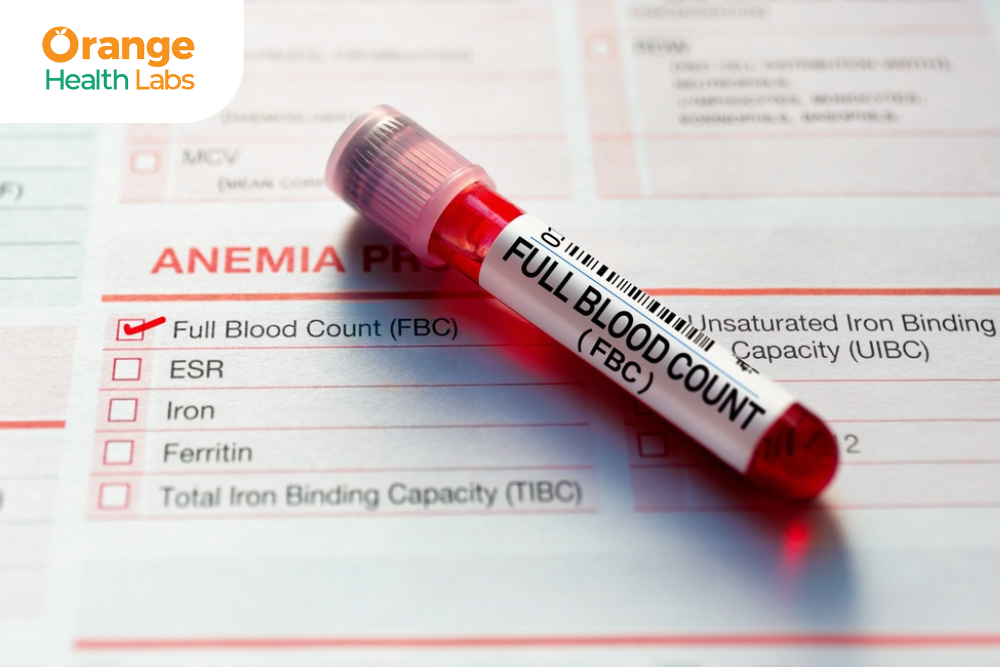Search for tests or checkups
SupportIs Your Child Growing at a Healthy Rate? Key Milestones

As parents, one of the biggest questions we ask ourselves is: “Is my child growing normally?” With every birthday and school term, we quietly wonder whether they’re tall enough, active enough, or hitting their milestones on time. But what if there were signs we might be missing—signs that regular checkups could catch early?
This guide will help you understand what healthy growth looks like for Indian children, how to track it, and when to consider expert help. Plus, we’ll show you how Orange Health Labs offers a simple, accurate way to monitor your child’s development from the comfort of home.
Why Tracking Growth is Crucial in Childhood
Growth is a Mirror of Health
More than just numbers on a chart, your child’s growth reflects their nutrition, hormones, emotional wellness, and overall health. Falling behind on expected growth patterns may not seem urgent, but it can signal deeper concerns—many of which are easier to manage when caught early.
Why the First 15 Years Matter the Most
The human body grows at its fastest rate from birth to adolescence. By the time a child turns 18, most of their skeletal, muscular, and hormonal development is complete. That’s why these years are considered the “window of opportunity” for building lifelong health.
Delays Can Be Easy to Miss
Without consistent tracking, growth issues can go unnoticed. A few centimeters off one year might not seem like much, but over time it could lead to a bigger gap in physical development. Early detection often means fewer interventions—and better outcomes.
What Are Normal Growth Patterns for Children?
What Growth Charts Really Mean
Doctors use growth charts—like those from the WHO and Indian Academy of Pediatrics (IAP)—to compare a child’s height, weight, and BMI to standardized values. These charts use percentiles to show where your child stands in comparison to peers.
Understanding Percentiles
If your child is in the 75th percentile for weight, it means they weigh more than 75% of children their age. However, being on the higher or lower end isn’t always a concern. What matters most is consistency in their growth curve over time.
Growth Differences Between Boys and Girls
Yes—girls tend to experience growth spurts earlier, often between ages 9–11, while boys grow more rapidly from 12–14. This is completely normal, and growth charts account for these gender-specific variations.
Key Physical Milestones by Age Group
0–12 Months: Foundation Year
Expect your baby to triple their birth weight and grow about 25 cm in their first year. Milestones include rolling, sitting, crawling, and saying their first words.
1–5 Years: Skill Building Phase
This stage is filled with curiosity and coordination. Children begin to walk, talk, feed themselves, and develop muscle control. Physical growth slows slightly but remains steady.
6–12 Years: Learning & Growth
Kids refine their gross and fine motor skills, start school, and grow mentally as well as physically. Tracking during this phase helps ensure they’re thriving in all aspects.
13–18 Years: Puberty & Growth Spurt
This period brings rapid changes driven by hormones. Monitoring is key to catching any imbalances that could affect final height, emotional stability, or reproductive health.
Common Health Issues That Affect Growth in Children
Nutrient Deficiencies
Low levels of iron, calcium, vitamin deficiencies can lead to anemia, weak bones, frequent illness, and reduced energy—all of which affect growth and learning capacity.
Endocrine Conditions
Hypothyroidism and growth hormone deficiency are often behind unexplained short stature. These can be easily detected with blood tests and treated with medication or supplements.
Chronic Illnesses
Conditions like celiac disease, frequent infections, or asthma may silently hinder growth. Regular health checks help you connect the dots early.
Stress or Emotional Deprivation
Children under emotional distress may show slowed growth, even in the absence of physical illness. Growth tracking also helps bring psychosocial factors to light.
Tests That Help Assess Growth Concerns
- Complete Blood Count (CBC): Assesses anemia and infection.
- Ferritin Test: Detects iron deficiency.
- Vitamin D, Total: Crucial for bone growth and immunity.
- Vitamin B12: Supports brain and nerve development.
- Calcium - Ionised: Essential for skeletal strength.
- Thyroid Function Test (TFT): Diagnoses hormonal growth delays.
- HbA1c: Screens for earlier blood sugar signs that affect energy.
- Magnesium (Mg): Important for muscle and nerve coordination.
- Cholesterol Total: Identifies early signs of metabolic disorders.
- Immunoglobulin E (IgE): Helps uncover allergies impacting nutrition.
Children Focused Health Checkup Package
To make this process easier, Orange Health Labs offers a specialized health checkup that includes all the essential tests listed above. This package helps parents track their child’s development without stress or uncertainty.
- CBC, Ferritin, Vitamin D, and B12 for nutrition
- TFT and HbA1c for hormonal and metabolic health
- Calcium, Magnesium, and Cholesterol for physical growth markers
- Total IgE for allergy screening
The sample is collected at home by trained child-friendly phlebotomists, and reports are delivered within 24–48 hours. No hospital visits. No queues. Just reliable results and peace of mind.
How to Book Your Child’s Checkup Online
Simple Booking Process
Visit the Orange Health Labs website or app. Browse for children health packages, select the test, and book a slot that suits your schedule.
Choose Your City and Address
Enable location access or select your city manually. Enter your complete address and confirm the appointment—easy, fast, and intuitive.
Fast Reports and Expert Support
Reports arrive via email or WhatsApp within 24–48 hours. Need help understanding the results? Orange Health Labs offers expert consultations regarding the checkup result.
Children's Health Checkup in Bangalore | Children's Health Checkup in Mumbai | Children's Health Checkup in Delhi | Children's Health Checkup in Noida | Children's Health Checkup in Gurgaon

Is PCOS the cause behind your ACNE?

Top Blood Tests That Require Fasting & Why It's Important
